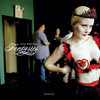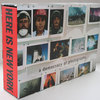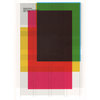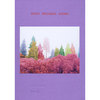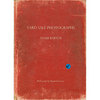Conversations about Photobooks: Alice Rose George
MORE IMAGES
“I think that ebooks will be huge. […] In a way, [the ipad] is really perfect for certain kinds of photography books. The one thing that we will lack there is the packaging, the materials. We will have a design, but we won’t have the tactile experience, and people will just have to pay extra for the hard copy.” - Alice Rose George
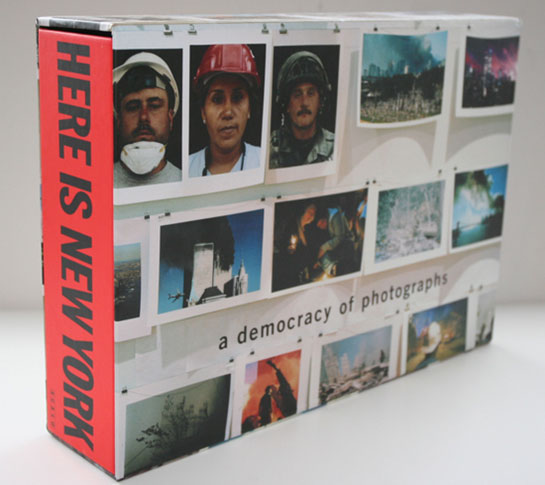
Late last year, I had the opportunity to teach a class on the contemporary photobook with Alice Rose George, as part of the Hartford Art School Photography MFA Program. Even outside the classroom, Alice and I spent a lot of time talking about photobooks, where things were, where they are now, and where they’re going. As an independent photography editor and curator, who has worked extensively with private and corporate collections, book publishers and magazines, Alice’s knowledge of the photobook publishing world is almost limitless. Among the publications she worked on/was involved in are Hope Photographs, 25 and Under (whose exhibition she also curated), Andrew Moore’s Detroit Disassembled, Adam Bartos’ Yard Sale Photographs and many more. As one of the four founders of Here Is New York: A Democracy of Photographs (see the book), she has helped to create one of the most remarkable tributes to the people and events of September 11, 2001. Alice also served as the Director of Magnum New York and the Publisher of Granta in England. The following is a conversation I had with her about Here Is New York, photobooks in general, and ebooks. (more)
Jörg Colberg: I thought we’d start of by talking about Here Is New York, because it’s both an important and unusual book. Can you describe how the book came about?
Alice Rose George: A week after September 11, a friend of mine, Michael Shulan, was sitting in an empty space in SoHo because his tenants had backed out of the lease. Gilles Peress called him (they had met over real estate) and asked “What are you doing?” Michael said “I’m sitting here, in this empty store in Soho, and I don’t know what to do.” Gilles said “Why don’t you start a gallery? Call Alice.” So the three of us got together. We had each been struck by the fact that everyone had been and was taking pictures. We decided to try to open up the space for anybody who had photographs they wanted to show. All of the ideas around Here is New York grew organically, there was no great plan. We provided the space. I called about a dozen professional photographers who gave us images which we hung. A collector I was working for, Howard Stein, came through with enough financial support that we could turn on the lights and get the place insured. We opened the doors.
From the first day, people came to the gallery. Quickly, an incredible explosion of participation took place, with thousands of people bringing their photographs as though they were gifts, as a way of expressing what they had experienced. The lines grew around the block, people came to look, to relive the horrendous experiences, to buy images. It became a meeting place - though silence reigned - where a sense of community gave some solace. An national and international press spread the news of what was going on. We printed images out on computers and hung on clothing lines. We sold thousands of pictures and by the end had made over a $100,000.000 for charity.
Within the first week, I had a call from a literary publisher saying he would be interested in a book. Others contacted us. The idea of a book developed slowly, we weren’t thinking “book” . Instead, it was the whole experience, of the gallery, of sharing these photographs that was driving us. But in the end, the book was a very natural part of the experience.
Scalo published the book. Everybody had a hand in its making, in one way or another, in the writing or the production or the editing… We considered it very much a communal effort.
The book is huge. The idea of having all the pictures is to give the reader the sense of what the gallery and the experience was. It’s not a conventional book, it has way too many pictures, but it’s cumulatively very effective, I think, and reflects the original force, while adding to and becoming a thing unto itself.
JC: How many images did you have in the gallery, how many images did people bring in, and how many ended up in the book?
ARG: Oh my gosh! At one point I knew. It was thousands and thousands of images. We used hundreds of pictures in the book. The page count is 864!
JC: How did you decide which images to include?
ARG: We had already edited to determine which pictures would go on the walls, because we had more pictures, of course, than we could show. There were several edits. I did an initial edit, Gilles did another edit. It was just a matter of pulling the images that said something. We weren’t looking for “art photographs” but good photographs which told the story. It wasn’t what I would call a normal book edit.
I’m actually reminded of Nan Goldin who did the wonderful The Ballad of Sexual Dependency as a slide show, with hundreds and hundreds of pictures, and with music. When she got a book out of it, it was a very pristine book, very much a book edit. It didn’t have the feel of what her presentation had been. It was another thing altogether.
With Here is New York we tried to have a book that reflected the whole atmosphere, exhibition… the event. I think event is a better word than exhibition.
JC: In general when you produce a book do you want to convey the experience of seeing the gallery show?
ARG: No. A gallery show no. I would think any book should reflect the whole body of the work on a particular subject or genre in terms of size, number of pictures, sequencing. Books are not exhibitions, nor vice versa. A catalogue, which is made of images from an exhibition, can be very valuable but that seems different from a “book.” And Here is New York wasn’t to be a catalogue, it was to be another reflection on the event.
JC: Speaking about photobooks in general, what makes a good photobook for you?
ARG: Pretty simply: Really good pictures, whether it’s a monograph, as an expression of the photographer’s art work, or whether it’s a photobook about a subject. It’s really the quality of the photographs that makes me buy a book.
The feel of the book is important. It’s a very tactile and sensual experience to hold a book, so that also matters. Sometimes, I like books because they’re such beautiful objects. But the most important thing for me is still the photographs. Secondly, the feel of the book.
JC: By feel you mean the materials themselves or the way it’s put together: the edit, the sequencing, maybe the design?
ARG: I would say it’s the design and the materials, because the photographs imply for me already an edit and a sequence which is integral to the photographs. It’s hard to see good photographs when they’re badly edited and sequenced. So I put those all together, and then I see the packaging as the other part.
JC: You’ve been involved in the making of lots of books. I don’t know whether I’m asking you to give away some of your secrets here, but when a photographer meets with you and you have an idea for a book how do you develop the feel of the book? Do you take what the photographer says and then translate that into what you think the book should be? How does that work for you?
ARG: Of course, every case is different. Let’s take an example. A French photographer came to me. He wanted me to see his dummy. I realized it was so badly put together, that he wasn’t giving the book what he should, so I just started reshuffling pictures. He liked what I was doing so much that we redid the entire book together.
Sometimes a photographer will come to me with a box of prints, and I just keep looking at the pictures until I start understanding what the core is. It’s like the pictures ask me to pull them together in a certain way. A form begins.
I love working with the photographer, I certainly think the photographer is the final editor. And I listen to the photographer, but I don’t think they always see what they have. As an outsider, I can sometimes see more clearly.
JC: Photographers often are really bad editors.
Alice: Sometimes, they are. But sometimes, they’re very good. Every now and then you have one that’s very good.
JC: How do you usually solve that? You have a lot of experience editing.
ARG: I listen to the photographer. If he or she feel strongly about something and I just can’t see it and we can’t resolve our different approaches, I will divorce myself from the project. When I feel it doesn’t make sense to me, I say “I don’t agree with what you’re doing, but it’s your book.” Sometimes, after reflection one or both will go back to the other and resume the collaboration.
Regardless of whether I speak as the publisher of the book or a person that’s been asked to help in the edit, I try to be honest.
JC: A book is always a collaboration. I don’t know whether people realize this. Nowadays, there’s so much talk of on-demand publishing, of how you can publish your own book. I don’t want to belittle it in any way. But I feel what’s often forgotten in this debate is that there’s so much to be gained from involving an editor, or a designer.
ARG: I think you’re right. Almost everything is better by conversation or by some kind of interplay with another person. I also write, and I know that an editor, just by the fact that they look at and read what I’m writing, changes the way that I write. Or maybe I should say it doesn’t change the way I write, but it brings out the better part of me.
Actually, I also find that in the commercial world, there’s not enough editing. Publishers used to be very hands-on, they made books with the artists. But now, it’s very much “You just give me your book,” and they publish it if they figure they can break even or even make money from it. I don’t think that’s publishing a book, that’s a very different thing to me.
JC: I noticed that some books are just very poorly edited. You look at the colofon, to see who edited the book, and there is no editor.
ARG: Usually, if the publisher doesn’t have the money to pay an editor there is none. I have also found that galleries, which are very important for the photographers, get involved with the books. Sometimes they put up some money. They don’t always understand that a book is very different from an exhibition or that it is not just a vehicle for marketing. The gallery and the editor/publisher may work with the same material, but they’re working from different angles. So I think editors are really important. Or good publishers.
JC: We’ve seen more and more independently published books. What is your general impression of what is going on right now, having all these new publishers popping up and producing books?
ARG: It’s fantastic. I think some of the most exciting times that I’ve had recently looking at photography, feeling the freshest, has been Offprint in Paris and the book fair here in New York, at P.S.1.
I don’t know how these new publishers survive. Commercial publishers walk into a publication with the question “How will this do financially?” They’re businesses. They have whole staffs of people and all kinds of things they have to support. So money is one of their first concerns. I guess the smaller publishers are probably younger people. They can’t be that concerned with money, or they couldn’t do it. There are some very exciting things happening right now, and I learned a lot from that class we taught.
JC: The other day I was thinking that this really is the golden age of photobook publishing. But when you think about money… At some stage a lot of it might just disappear because I don’t know whether it’s sustainable.
Alice: Frankly, I don’t think so. This kind of publishing is wonderful because it’s young, it’s about the ability to cast off concerns about the future. But at some point these publishers will have to deal with more material concerns. It’s just the nature of staying around! And a few will last, of course. But they will probably become more like regular publishers, retaining, one hopes, a bit more insight into what’s really good.
JC: I was going to ask you what can we do to sustain what we have right now, especially since it seems that regular publishers are cutting back.
ARG: They are. The ones I talk to say “This will have to bring in a certain amount of money”. How to sustain the swell of newer publishers? I don’t know. I’m not sure but that by its very nature it must reach a crescendo and then sink. To rise again, yes?
JC: Maybe I’m too pessimistic about it. Of course, I have an interest in this situation staying more or less the way it is right now, because I love books. There are just so many good books to pick from right now.
ARG: Well, you know, most of the public doesn’t see the books you’re talking about. They only see the big commercial books which are distributed to the big book sellers. So one of the problems is getting these books out in the world more and creating talk about them. You’re certainly doing your part. But people don’t know these books. Even I, who’s certainly aware of things, was not as fully aware of what was happening in this world until about a year ago. I went to one of the art book fairs and saw what had mushroomed. More people go to these book fairs and see the work now. But even when you have five thousand people going that doesn’t lay the groundwork for a sustainable business.
JC: Do you have any ideas what people can do to spread the word?
ARG: I think that blogs are what will do it. I don’t think there’s any other way, small independent publishers can’t afford regular advertizing.
I’m very interested in ebooks for photography as part of publishing. The industry has to change, because of the way our world is changing. The books we’re talking about are almost a throwback to the past, because they’re handmade, they’re personal visions. They’re almost romantically wonderful.
JC: They might actually in part be a reaction to everything going digital.
ARG: They very much could be, except that the new technology is used to make them, which I find interesting. I think that’s probably one of the reasons new publishers can afford to publish.
JC: Let’s talk a little bit about ebooks and photobooks. What are they gonna look like? A lot of people say “This is just not gonna work, it’s not the same experience, holding a book and looking at pictures on a plastic screen.”
Alice: Ebooks will definitely come, there’s no question about it. I don’t think they will replace the hand-held book, nor should they.
I don’t really understand the technology, but from what I hear, right now companies are not set up to really show graphic books to their advantage on the apps we have. I think that they should be able to find a way to do photographic ebooks, without it having to be multimedia. Photographs do look good on the ipad. We just need a platform for showing them.
I think ebooks will sell well because they can sell at, say, ten dollars. Just think how wonderful it would be to be able to get all these ebooks to find out what you really have to have in your hands!
As I mentioned in the class, I think the real books will become a very elitist item because it will have to be more expensive.
I think that ebooks will be huge. If you look at the ipad, you watch movies on it, and you can carry it around. In a way, it’s really perfect for certain kinds of photography books. The one thing that we will lack there is the packaging, the materials. We will have a design, but we won’t have the tactile experience, and people will just have to pay extra for the hard copy.
JC: Ebooks would then offer a way for photobooks to break out of the little ghetto they’re in right now, because they would be so much more easily available.
Alice: Yes, exactly! And people might actually start buying the real books. As it is now, photobooks are marketed to photographers. They don’t sell very many copies. But if you can have them under other categories, and people can buy them for not very much money, people would be exposed to more photography and, we hope, start buying some books. That’s an optimistic point of view.
 By
By 
